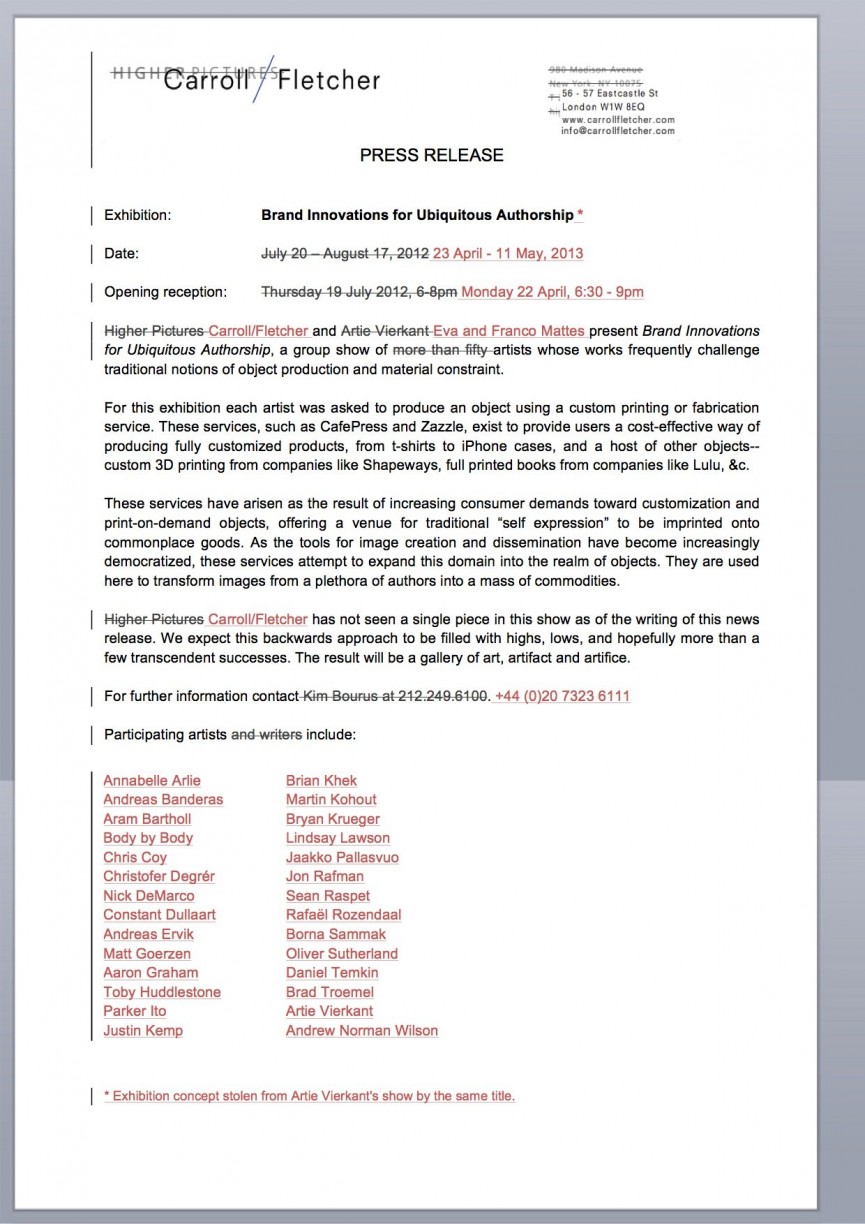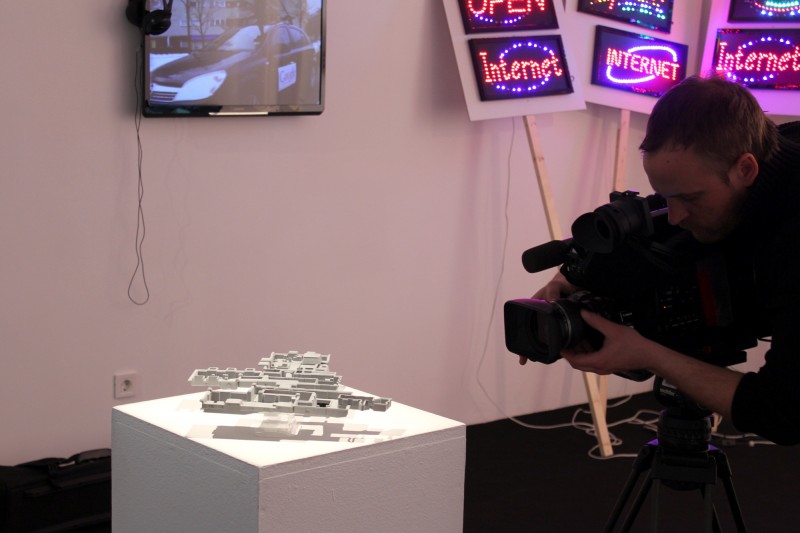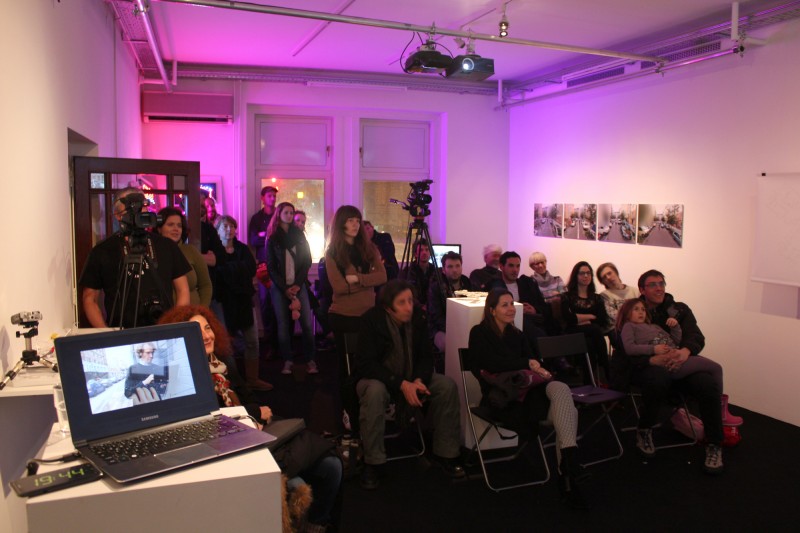Archive for March, 2013
Brand Innovations for Ubiquitous Authorship 2
I ll show a new piece “Forgot your password?” at Eva & Franco Mattes’ ‘stolen’ show at Carroll/Fletcher next month. (See also where Artie has ‘stolen’ the concept from before ;))) Nice press release! I took the liberty to OCR it into machine readable format below. (NOT EDITED!!! :)
———————————————————————————————————————————————————————
i ;_56<57 Eastcastle St
London WIW sso
www.carrolItletcher.com
info@carrolltletcher.com
PRESS RELEASE
Exhibition: Brand Innovations for Ubiquitous Authorship
Date: m2 23 April – 11 May, 2013
Opening reception: 3Fhursday-19-July-2012-,-6-8pm Monday 22 April, 8:30 – 9pm
Carroll/Fletcher and Eva and Franco Mattes present Brand Innovations
for Ubiquitous Authorship, a group show of anists whose works frequently challenge
traditional notions of object production and material constraint.
For this exhibition each artist was asked to produce an object using a custom printing or fabrication
service. These services, such as CafePress and Zazzle, exist to provide users a cost-effective way of
producing fully customized products, from t-shirts to iPhone cases, and a host of other objects-
custom 3D printing from companies like Shapeways, full printed books from companies like Lulu, &c.
These services have arisen as the result of increasing consumer demands toward customization and
print-on-demand objects, offering a venue for traditional “self expression” to be imprinted onto
commonplace goods. As the tools for image creation and dissemination have become increasingly
democratized, these services attempt to expand this domain into the realm of objects. They are used
here to transform images from a plethora of authors into a mass of commodities.
Higher-Pietu+es Carroll/Fletcher has not seen a single piece in this show as of the writing of this news
release. We expect this backwards approach to be filled with highs, lows, and hopefully more than a
few transcendent successes. The result will be a gallery of art, artifact and artifice.
For further information wnmct . +44 (0)20 7323 6111
Participating artists andwriters include:
Annabelle Arlie Brian Khek
Andreas Banderas Martin Kohout
Aram Bartholl Bryan Krueger
Body by Body Lindsay Lawson
Chris Coy Jaakko Pallasvuo
Christofer Degrér Jon Rafman
Nick DeMarco Sean Raspet
Constant Dullaart Rafael Rozendaal
Andreas Ervik Borna Sammak
Matt Goerzen Oliver Sutherland
Aaron Graham Daniel Temkin
Toby Huddlestone Brad Troemel
Parker Ito Artie Vierkant
Justin Kemp Andrew Norman Wilson
Exhibition concept stolen from Artie Vierkant’s show by the same title.
Vertical Video DVD
DVD Dead Drop vol.6: ‘Vertical Video’
March 19 – May 7, 2013 at the Museum of Moving Image NYC
by Sakrwoki aka curatingyoutube.net and Aram Bartholl. 2013, 62 mins. DVD.
Vertical Video is a one-hour selection of amateur videos captured in the 9:16 aspect ratio, first compiled for a special screening in Berlin entitled Vertical Cinema. The DVD includes a special How To video with instructions for adjusting a home theater or other viewing environment to properly experience these works.
Fueled by a proliferation of mobile, inexpensive, high quality cameras and free online distribution platforms, self-trained media producers continue to invent creative uses for media technologies that challenge contemporary viewing behaviors and expectations. Even though the 9:16 aspect ratio is often understood to be “wrong” €“the result of using a camera “incorrectly” €“videos in 9:16 are being created and distributed online at an increasing rate. Unchained from cinema screens, televisions, and computer monitors, media makers are free to create for viewing experiences outside of traditional horizontal exhibition hardware.
Vertical Video is a compilation of videos with a wide range of subjects including architecture, wildlife, bodies in motion, gaming, eyewitness accounts, and current events whose vertical treatment is a natural and fitting decision. Until now, many of these videos have only been seen online where they have been thickly pillarboxed and shrunk to squeeze into the existing horizontal viewing system. This compilation provides evidence that a new generation of media producers, freed from concerns about conventional screening requirements, reject the arbitrary restrictions of the horizontal screen and maintain a more fluid relationship with the frame.
The selection was originally screened at Vertical Cinema Platoon Berlin on Feb 18 2013, see also http://datenform.de/vertical-video-eng.html
OFFLINE ART: new2 opening speech by Olia Lialina
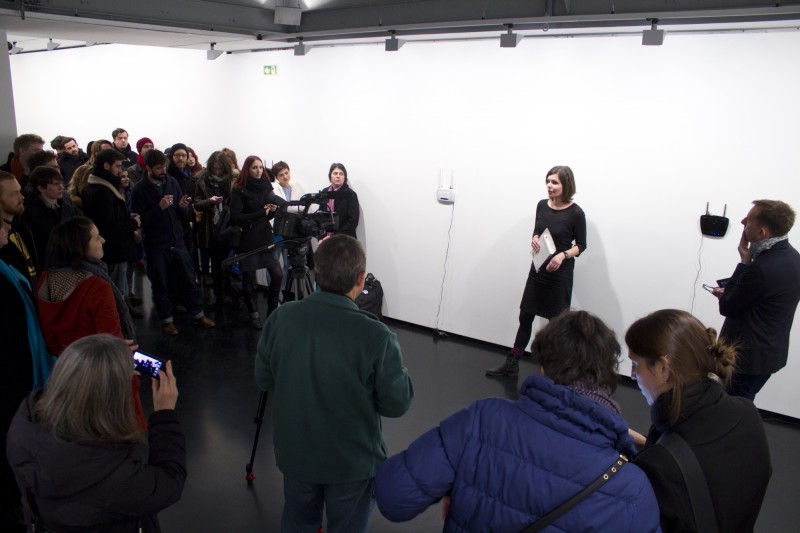
Olia Lialina opening the show at xpo gallery Feb 21, 2013
For the opening of OFFLINE ART: new2, curated by Aram Bartholl at XPO Gallery.
Let me steal a few seconds of your attention to remind you about some obvious facts and terms. The Internet and the Web are not the same. The Internet is older and bigger, it is a distributed network born in 1969 and turned into a global Internetwork at the very beginning of the 80s.
The Web is younger. In two months we will celebrate its twentieth birthday. The first cross-platform browser, Mosaic, was released to the public in April 1993. There are people who date the beginning of the Web to 1989, when Tim Bernes Lee invented the WWW system, but nothing happened between 1989 and 1993. Nothing before the rest of us started to shape it.
The Web is younger and “smaller.” It began in 1993 as a modest service, one of many. I have a book here with me, “The Whole Internet” – I always have it with me. It has 400 pages and only fifteen of them are about the Web. But it was growing very fast. By 1995, it would make no sense to write a book entitled “The Whole WWW” or something similar, because it was already immense by this time.
The Web became the Internet very quickly. In the 90s many got to know about the Internet through the Web. Many never ever left the Web, so they haven’t seen the rest of the Internet. In the new millennium, most of the users don’t even know there is a difference. I sometimes get angry at new students who don’t know about it, but at the same time, I’m fine with this because the Web is the best thing that happened to the Internet. The best thing that happened to us. It is the best thing that could happen to artists and to the contemporary art world, though not everybody would agree with this.
Apart from the many doors and windows that it has opened to artists and institutions, the Web gave life to a very important movement: net art – or, as one would have called it during the mid 90s, net.art.
Retrospectively, we can say that it gave life to two art forms: web art and net art. The first was busy with browser, HTML and scripts, with the idea – revolutionary at the time – that a browser IS a place for self-expression, for experimentation, for making art. Net art was busy with networking itself.
In the beginning, web and net art were represented by the same people. They – I mean, we, worked for the Web, on the Web and because of the Web. But we didn’t want to be called web artists; we liked being called net artists. The reason is that, for net artists, visual and coding experiments with browsers were less important than the fact that our works were ONLINE.
Artists of that generation emphasized connectivity, networking, and the distributive nature of the works through several means. There was a great desire to create projects that weren’t visible on a computer that was NOT online. Today, we often hear that there is no difference anymore between offline and online, that they are both real life. True. Twenty, fifteen years ago, we knew very well when online stopped and offline started, where net art stopped and where CD-ROM, interactive or whatever art started.
A show that goes back to the initial idea of net art opens tonight. It focuses on connection, its presence, and its absence. It even starts off with a provocative title. I don’t know what you think about when you read OFFLINE art, but I can only think about ONLINE art.
OFFLINE ART: new2 was curated by one of the most important new media artists, Aram Bartholl. His objects and installations in public places precede today’s art and design trends that play with the relationship between the digital and analog worlds. But he is also a net artist, a classic net artist, because he keeps himself busy with the question “am I on or off?”
This question was and still is central to net art, despite new realities, new devices and generational change.
Aram is also a brave artist, because he is not afraid to enter into one of the most slippery issues related to contemporary and media arts: Does it make sense and is it possible at all to show net art in a gallery or real space?
I have been involved with this discussion for the last fifteen years through my own artistic and curatorial work. I can tell you that the answer has changed from a definite No to Maybe, to Yes, but and finally, to Yes.
It became clearly positive some years ago, when the Web stopped being a new medium and became a mass one. It was quite a difficult moment for net art and web art, because these forms are extremely medium-specific. Web artists and net artists are doing work about the medium, but, as soon as it stops being new – when it a matures, when it becomes a mass medium, it becomes very difficult to have a close connection with it. By the way, many net artists went OFFLINE at that time to make works “about the internet and the web” from the outside, in order to keep a distance, to keep the relationship alive.
But there was also a bright side to this: the fact that the Internet became a mass medium meant that net artists got bigger audiences, both online and offline. Ten years ago it made sense for net artists to only address people in front of their computers; today, I can easily imagine addressing visitors in a gallery because most of them have just gotten up from their computers. They have the necessary experience and understanding of the medium to get the ideas and jokes, to enjoy the works and to buy them.
What is especially interesting about today’s exhibition is the fact that it counts on people who came not only with knowledge but also with their own mobile devices. So you are here and you are in front of your own computers again.
How to show net art in the real space? Another eternal question
OFFLINE ART is not Aram’s first answer to it. Three years ago, he conceptualized Speed Shows, an exhibition format that suggested renting an Internet café for one evening and opening online works on computers in a standard browser with standard preferences. It was a great gesture and I’m happy that these series of events still happen all over the world, because it is important to go to Internet cafés, to sit at least once in a while in front of a public computer. It was great for net art because a standard computer with a standard browser is a natural atmosphere. It is much healthier than installations and custom built objects around a work that only needs a browser. “Net.art never died! It just moved to your local Internet-shop!” was the motto of the series. The paraphrased motto of OFFLINE ART could be “net.art never died! It just moved to your local network!”
Once again, Aram suggests showing (distributing) the works through standard devices – Wi-Fi routers. They are modified, though. One router, one artist, one work of art: one network per artist. It is elegant and almost absurd.
This can be very attractive for collectors, who were always warned that you couldn’t buy net art; for this, you’ll have to buy the whole network. Well, here it comes, the artwork and the network.
I’m sorry if it sounds a bit sarcastic, but it is not because I’m against selling. I think, and I have repeated this for fifteen years, that selling web art is easy. Any other art form is more problematic than a web-based one, especially when it comes to pragmatic and legal issues. Additionally, there are so many ways to do it, so many ways to reshape and re-contextualize, to keep and collect. OFFLINE ART is an example of how it can be done.
We can try to see today whether this setting works and how it works. Will you look at the router or will you look at the work it is transmitting? Will you go through one router to another, or stay for hours in front of one? Will you keep the files you’ve downloaded on your devices and transfer them to your nextphone or overwrite them immediately?
You can access the works of twelve artists who belong to the tradition of web art through the routers, and then buy the routers. For OFFLINE ART, Aram selected classic and new works that play with web culture and browser aesthetics. They are all accessible through browsers, not apps. I think it is great to do this in 2013, because at this moment it looks like apps are taking other, but it is not true. Web designers and browsers will adjust to the small screens in the near future and the Web will once again become the environment we are in, even on mobile phones.
As soon as you connect your devices to each of the routers you will get a beautiful piece of web art. The exhibition itself is a wonderful net art project. Thank you for paying attention to both, for keeping both movements alive
Olia Lialina, 21 February 2013
I pass this new2.odt to you. Please scan, spell-check and put it online :)
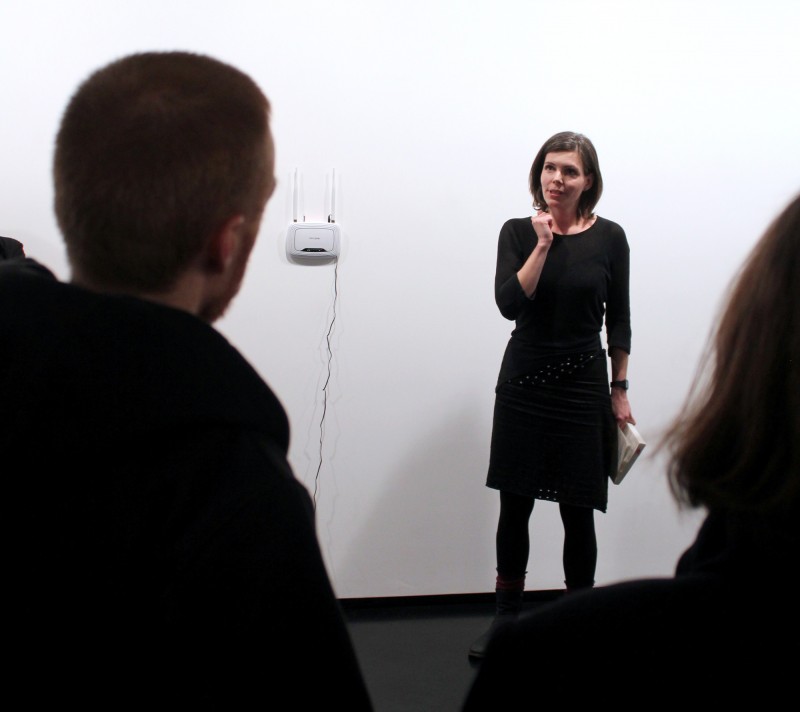
Olia Lialina opening the show at xpo gallery Feb 21, 2013
Thx to Olia for this wonderful and very important opening speech!
Go!Go!Go!
![]() Aram Bartholl
Aram Bartholl
»Go!Go!Go!«
Solo Exhibition
Aksioma | Project Space
Komenskega 18, Ljubljana
6 – 22 March 2013
![]() Exhibition opening and artist presentation:
Exhibition opening and artist presentation:
WED 6 March 2013 at 7 pm
